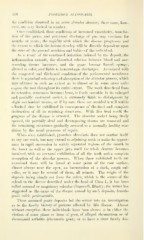Page 520 - My FlipBook
P. 520
518 PYORRHEA ALVEOLARIS.
the condition ohsorvcd in an acute alveolar abscess; these cases, how-
ever, are very liniitecl in number.
Once established, these conditions of increased vascularity, tumefac-
tion of the gums, and persistent discharge of pus may continue for
months or years ; the ra])idity with which the disease ]ir()grcsscs and
the extent to which the lesions develop will be directly dependent upon
the state of the general nutrition and habits of the individual.
As a result of the continued irritation induced by the deposit, the
iuHammatiou extends, the disturbed relation between blood and sur-
rounding tissues increases, and the gums become flaccid, spongy,
altered in color, and liable to hemorrhagic discharges. Associated with
the congested and thickened condition of the pericemental membrane
there is a gradual softening and absorption of the alveolar process, which
may advance to such an extent as to almost or in some cases quite
expose the root throughout its entire extent. The tooth thus freed from
its retentive structures becomes loose, is freely movable in its enlarged
and partially destroyed socket, is extremely liable to dislodgment by
slight mechanical means, or if by care these are avoided it will within
a limited time be exfoliated in consequence of the final and complete
destruction of all its retaining structures. With this final result the
progress of the disease is arrested. The alveolar socket being freely
opened, the partially dead and decomposing tissues are removed and
the remaining structures gradually restored to a normally healthy con-
dition by the usual processes of repair.
When once established, pyorrhea alveolaris does not confine itself
to any one tooth, but may extend to adjoining teeth or make its appear-
ance in rapid succession in widely separated regions of the mouth in
the lower as well as the upper jaws until the whole denture becomes
involved, with an eventual exfoliation of all the teeth and a complete
resorption of the alveolar process. When these exfoliated teeth are
examined there will be found at some point of the root surface,
almost always near the apex, an incrustation of a dark, rough cal-
culus, or it may be several of them, all minute. The origin of the
deposits being clearly not from the saliva, which is the source of the
calculi in the disease described under the head of Class I., it has been
called serumal or sanguinary calculus (Ingersoll, Black) ; the writer lias
suggested as the name of the disease caused by such deposits, hemato-
genic calcic 2^cricementitis.
These assumed gouty deposits led the writer into an investigation
as to the family history of patients affected by this disease. Almost
without exception these individuals have been shown to be either the
victims of some phase or form of gout, of alleged rheumatism or of
rheumatoid arthritis (rheumatic gout), or to have a clear family his-


